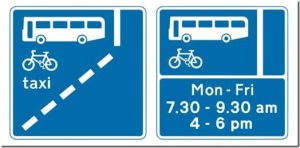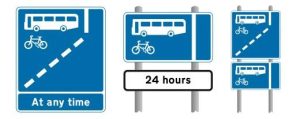 One fairly common reason people fail their driving tests is because they don’t use bus lanes properly. Unfortunately, a contributing factor is that very few so-called ‘experienced’ drivers know how to use them, either. And to make matters worse, the people who work for local councils and the contractors who produce bus lane signs also appear clueless.
One fairly common reason people fail their driving tests is because they don’t use bus lanes properly. Unfortunately, a contributing factor is that very few so-called ‘experienced’ drivers know how to use them, either. And to make matters worse, the people who work for local councils and the contractors who produce bus lane signs also appear clueless.
Bus lane signs don’t always look exactly like the ones shown in the Highway Code. They’re very similar, but there is some variation. The Highway Code identifies simple bus lanes using signs similar to those shown above. The one on the left refers to what is known as a ‘24-hour bus lane’, and you are not allowed to drive in it as if it were a normal lane at any time (I’ll discuss this further a little later). The one on the right gives days and times during which the lane is in operation as a bus lane, and outside those times you can treat it as a normal driving lane.
The first thing to understand is that the type of bus lane and its times of operation are set by local councils. The times I’ve used above are typical of most Nottingham bus lanes, though Rushcliffe Borough Council has recently chucked a spanner in the works by altering one in West Bridgford to operate between 3.30 – 6.00pm (a change that I doubt most drivers will be aware of, because I only realised it when I looked at the sign one day). Operating times are different in other cities, and it is up to the driver to check. A 24-hour bus lane may or may not be usable by taxis (in Nottingham, wheelchair-accessible taxis can use city centre bus lanes, but they’re not allowed in borough ones). The appropriate icons or wording are added to or removed from signs as necessary.
Nottingham City Council has managed the following further – needless – variations on a 500m stretch of road for one particular 24-hour bus lane.

That one on the right is my favourite, because it is demonstrates a case of ‘we don’t know which sign to use, so we’ll use both of them’. The fact that each subsequent sign set is not the same as the previous one creates a hundred times more confusion for normal drivers, since the obvious implication is that something is different. It isn’t. But when the bus lane becomes time-controlled about a mile further on, everyone keeps out of it just to be on the safe side. The one on the left is extremely confusing if you’re already unsure, because it begs the question ‘does it mean I can use it at any time?’
Basically, there should be four simple variations for a normal bus lane. When approaching a 24-hour one the sign shown top left should be used. A variation of that with operating times underneath would warn of one you could use it at certain times. The one shown top right would warn that the lane you’re driving alongside has operating times, and the corresponding variation (the bottom add-on on the above right pairing used by Nottingham City Council) would tell you it was 24-hour.
Of course, the Highway Code shows several more complex situations, involving with-flow and contraflow lanes, and depending on where you live you may see these more often. But the basic principle is that if there are no hours of operation shown, you can’t go in it at any time. If times are shown, those are the times when it is a bus lane and you’re not allowed in.
Can you drive in a 24-hour bus lane at any time?
For normal driving, no. If you do, you’re likely to get a penalty charge notice (PCN) from the council if a camera sees you – and remember that buses have cameras fitted these days.
However – and you still need to be very careful here, because the attitude varies from council to council – in some places you may be allowed to dip into them to pass vehicles waiting to turn right. It would be stupid and petty if you were expected to remain behind a right-turner, leading to long tailbacks, but some councils really are stupid and petty (London springs to mind here), so be careful.
Nottingham City Council says, in its PCN explanation leaflet/FAQs:
…the Authorised Officer will have noted issues such as the following before considering the issue of a PCN:
- The bus lane is clearly marked and operational and the incident occurred more than 5 minutes after the restrictions started and more than 5 minutes before they ended
- There is no evidence that the vehicle has stopped to pick up or set down a passenger. If setting down a passenger the vehicle must have made every effort to move out of the bus lane as soon as it was safe to do so
- There is no evidence of action by a Police Officer or an On-Street Civil Enforcement Officer
- The vehicle’s actions in the bus lane were not merely clipping the start or end of the bus lane but if the vehicle entered the bus lane it proceeds for more than 20 metres (approx 4 continuous car lengths) after so entering
- At least a significant part of the vehicle infringed the bus lane restriction i.e. more than 50% of the vehicle’s width
- If the vehicle used the bus lane to gain advantage over traffic using the correct lane.
When a vehicle is observed to undertake a vehicle turning right into a side road, by using a bus lane during its time of operation, the Council will treat each case on its merits and try to adopt a common-sense approach. The driver of such a manoeuvre should ensure that the route back out of the bus lane is clear before undertaking. In most cases the discretionary 20 metres distance will not be exceeded.
Note that these comments apply equally to a non-24 hour bus lane during its operational period. So, in Nottingham at least, you can pass someone turning right by dipping into and then out of a bus lane which is in operation at the time. Obviously, you should check that it’s safe and that there are no buses (or other drivers) on your left before doing so.
Why do people stay out of bus lanes even when they could go in them?
If the bus lane isn’t in operation, the reason other drivers stay out of them is usually because they don’t understand how to use them and are playing it safe. It isn’t uncommon to see a huge tailback at traffic lights, even though the bus lane is usable as a driving lane.
When I’m driving – either on my own or with a pupil – it is funny how a bus lane can be completely empty in the visible distance, and it is only when we enter it that other drivers do so, often right in front of us just to prevent us passing them as they move slowly in the queue they’ve helped create. Quite simply, not using bus lanes correctly is dangerous for this reason alone.
Why is it dangerous if I don’t go in a bus lane when I’m allowed to?
If you’re going to want the left hand lane you’ll probably end up having to move into it when it has filled up with other traffic. That causes hold ups and the potential for accidents.
Remember also that other drivers tend to err on the side of being arseholes, and although you will find that you being in the bus lane will make some of them try to get past you at all costs, in most cases that is better than the equivalent situation of those same arseholes trying not to let you into the left-hand lane when you need to get in at the end of the bus lane.
Use the bus lane properly and you have less to worry about.
Will I fail my test if I don’t use the bus lane?
If the bus lane is not in operation, and therefore a normal lane, then yes, there is a good chance you will fail. The simple fact is that if you drive for any lengthy distance in the right-hand lane when the bus lane is not in operation – and it is empty/free of obstacles – then you are driving in the wrong lane. And people do fail for doing that, whether it’s a bus lane or not.
Some examiners might let you get away with it, but that would depend on how far you drive, how many signs you pass, and what effect you have on other road users and how they react. However, if you try to turn left across a bus lane when you could (and should) have been driving in it, then a fail is virtually guaranteed from my own pupils’ experience.
Yes, if you only didn’t use the bus lane for a relatively short distance, and if you did all the safety observations before turning across it, and if you didn’t cause any hold ups to traffic (or buses) in it, then it is possible the examiner might let you get away with it. They shouldn’t, but they might.
It’s best if you use them like you know what you’re doing, though. Then it isn’t a matter of chance.
What if I don’t know the area?
Look. If I travel to a city I have not been to before, if I drive in a bus lane when I shouldn’t then I will still get a ticket. Likewise, if I drive to a city I don’t know, by not using a bus lane when I should there is an increased chance of having a collision if I need to turn left. The same goes for other rules of the road. It’s why we have road signs and The Highway Code.
It is my responsibility to know when to use the bus lane and when not to. A learner taking their test is no different. The only difference is that I use bus lanes because I know how they work, and not because I am copying what others are doing. And that’s what my learners need to know.
If in doubt, stay out – but look for the signs and alter your behaviour accordingly.